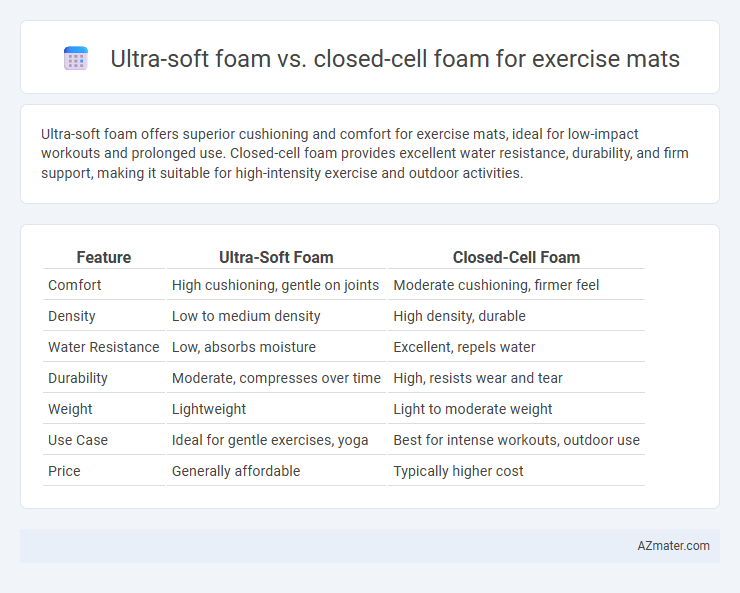Ultra-soft foam offers superior cushioning and comfort for exercise mats, ideal for low-impact workouts and prolonged use. Closed-cell foam provides excellent water resistance, durability, and firm support, making it suitable for high-intensity exercise and outdoor activities.
Table of Comparison
| Feature | Ultra-Soft Foam | Closed-Cell Foam |
|---|---|---|
| Comfort | High cushioning, gentle on joints | Moderate cushioning, firmer feel |
| Density | Low to medium density | High density, durable |
| Water Resistance | Low, absorbs moisture | Excellent, repels water |
| Durability | Moderate, compresses over time | High, resists wear and tear |
| Weight | Lightweight | Light to moderate weight |
| Use Case | Ideal for gentle exercises, yoga | Best for intense workouts, outdoor use |
| Price | Generally affordable | Typically higher cost |
Introduction to Exercise Mat Materials
Ultra-soft foam exercise mats provide exceptional cushioning and comfort, ideal for low-impact activities like yoga and stretching, due to their porous structure that offers excellent shock absorption. Closed-cell foam mats, composed of dense, non-porous material, offer superior durability, water resistance, and hygiene, making them suitable for high-intensity workouts and outdoor use. Choosing between ultra-soft and closed-cell foam depends on the balance between comfort, support, and durability required for specific exercise routines.
What is Ultra-Soft Foam?
Ultra-soft foam in exercise mats is a highly cushioned, flexible material designed to provide superior comfort and joint support during workouts. Unlike closed-cell foam, which is denser and resistant to moisture and bacteria, ultra-soft foam offers enhanced softness and pressure absorption but may lack the same durability and water resistance. This foam is ideal for low-impact exercises where comfort is prioritized over rigidity and long-term wear resistance.
What is Closed-Cell Foam?
Closed-cell foam is a dense, durable material with tightly packed cells that resist water, moisture, and bacteria, making it ideal for exercise mats exposed to sweat and outdoor conditions. Its structure provides excellent shock absorption and support, enhancing comfort during high-impact workouts. Ultra-soft foam, while more cushioned, typically lacks the moisture resistance and durability of closed-cell foam, making it less suitable for heavy-duty exercise use.
Comfort and Cushioning Comparison
Ultra-soft foam exercise mats offer superior comfort with a plush texture that conforms to the body, reducing pressure points during workouts. Closed-cell foam mats provide firmer support and excellent cushioning that resists compression, ideal for maintaining stability and preventing injuries. Both foam types vary in thickness and density, affecting overall comfort and shock absorption depending on workout intensity.
Durability and Longevity Factors
Closed-cell foam offers superior durability and longevity for exercise mats due to its dense, water-resistant structure that resists compression and moisture damage over time. Ultra-soft foam provides enhanced initial comfort but tends to degrade faster under repeated use, showing signs of wear such as flattening and tearing sooner than closed-cell alternatives. Choosing closed-cell foam ensures a longer-lasting mat that maintains shape and supportive qualities during intense workouts.
Support and Stability During Workouts
Closed-cell foam offers superior support and stability during workouts due to its dense, firm structure that resists compression and absorbs impact effectively. Ultra-soft foam provides enhanced cushioning and comfort but may compromise stability by allowing more sinkage, making it better suited for low-impact exercises. Choosing closed-cell foam ensures a stable, supportive surface for high-intensity or balance-focused training sessions.
Moisture Resistance and Hygiene
Closed-cell foam offers superior moisture resistance compared to ultra-soft foam, preventing water absorption and reducing the risk of mold and bacterial growth on exercise mats. Ultra-soft foam tends to absorb sweat and moisture, which can lead to unpleasant odors and hygiene concerns over time. For optimal cleanliness and durability, closed-cell foam mats are preferable for maintaining a dry and hygienic workout surface.
Portability and Storage Considerations
Ultra-soft foam exercise mats offer lightweight and flexible properties, making them highly portable and easy to roll or fold for compact storage. Closed-cell foam mats provide excellent water resistance and durability but tend to be denser and bulkier, which may impact ease of transportation and space-saving storage. Choosing between these materials depends on balancing portability needs with durability and moisture resistance for exercise mat use.
Best Uses for Each Foam Type
Ultra-soft foam exercise mats excel in providing cushioning and comfort for low-impact activities like yoga, Pilates, and stretching due to their superior shock absorption and pressure relief. Closed-cell foam mats offer enhanced durability, water resistance, and firm support, making them ideal for high-intensity workouts, outdoor use, and exercises involving heavyweights or mats that require easy cleaning. Selecting the right foam depends on balancing comfort needs and durability requirements based on the workout type.
How to Choose the Right Foam for Your Exercise Mat
Choosing the right foam for your exercise mat depends on durability, comfort, and intended use; ultra-soft foam offers superior cushioning and shock absorption, ideal for yoga or pilates, while closed-cell foam provides better water resistance and structural support, making it perfect for high-intensity workouts or outdoor activities. Ultra-soft foam mats typically have a thickness of 10-20mm, enhancing joint protection and comfort during floor exercises, whereas closed-cell foam mats, often 6-12mm thick, resist moisture, bacteria, and odors. Prioritize ultra-soft foam for low-impact exercises requiring softness, and closed-cell foam for robust support, longevity, and easy maintenance.

Infographic: Ultra-soft foam vs Closed-cell foam for Exercise mat
 azmater.com
azmater.com